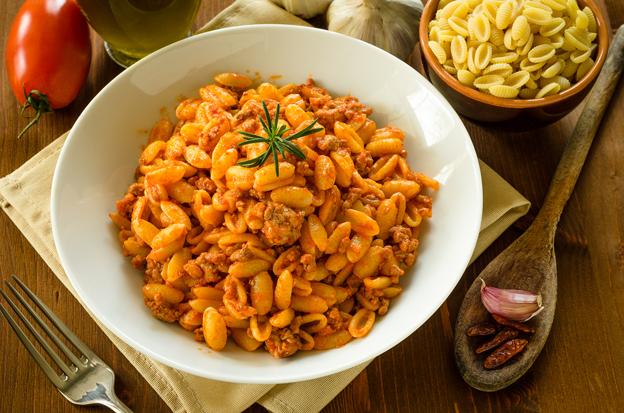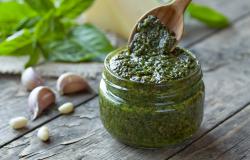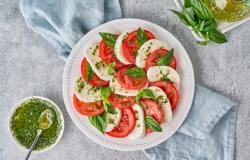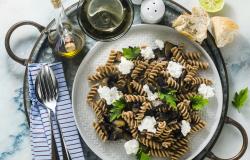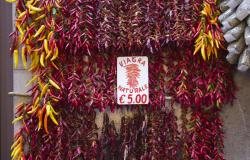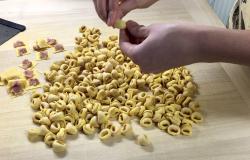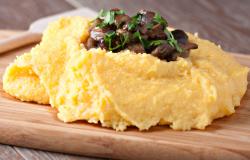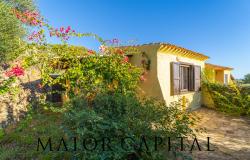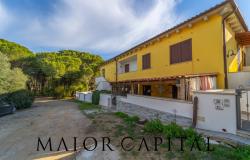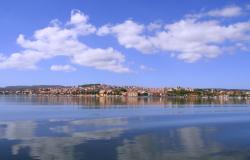Sardinian cuisine is extremely varied, enriched through the centuries by the exchanges and influences from other populations of the Mediterranean basin: Phoenicians, Carthaginians, Romans, Arabs and Spanish. Each area has its specialties; pasta, bread, cheeses, meat, seafood, and natural herbs are the basis for a range of tasty dishes to discover on a trip to this beautiful region.
Seafood
Sardinia is an island, it is therefore inevitable that seafood plays an important role in the region’s cuisine. In coastal towns, and especially Cagliari, Carloforte, Oristano, Alghero, Castelsardo, Santa Teresa di Gallura, Olbia, seafood and shellfish-based dishes abound. Some typical dishes of Cagliari, the capital of Sardinia, include: fregula (a type of pasta from Sardinia) with clams, spaghetti with clams and fish eggs (bottarga), spaghetti with sea urchins, sometimes served with artichokes or wild asparagus, cassola, a seafood soup.
In the south-western portion of the island, in the area known as Sulcis, are some of the oldest tonnare (tuna fishing nets) in the Mediterranean. The cuisine reflects a strong Genoese influence and revolves around tuna and other products related to the fishing of tuna.

[Cassola, a seafood soup.]
In the area around Alghero, lobsters prevail and are prepared the Catalan way (part of the population here descends from Catalan conquerors from the end of the Middle Ages): boiled with tomatoes, celery and onion and accompanied with a sauce made from the head with the addition of lemon juice, olive oil, salt and pepper.
In Santa Teresa and the Maddalena archipelago, octopus salad is a classic specialty, while in Olbia clams- and mussels-based dishes are commonly found. Quite unique, and found both in the north and south of the island, are the ortziadas or bultigghjata, floured and fried sea anemones.
Pasta
Like every Italian region, Sardinia too boast its own varieties of pasta. Here are some typical first courses made with local pasta:
Malloreddus (gnocchetti sardi in Italian) are made of semolina flour and are similar to gnocchi; they are traditionally flavored with saffron. They are typically prepared with a tomato and sausage sauce, called alla campidanese; other recipes include casu furriau, melted cheese and saffron.
Culurgiones are dumplings stuffed with ricotta and mint, or with a potato-based filling, fresh cheese and mint;
Fregula is hand-made dry pasta made from durum wheat semolina, worked in small lumps and used for dishes such as fregula with clams or fregula al sugo. It is also used to make soups. Fregula is where the North African influence is more obvious, being similar to cous cous, but with larger grains.

[Fregula, a typical Sardinian pasta.]
Zuppa Gallurese (soup from Gallura) consists of Sardinian bread, casizolu, spices and cheese, softened with broth and cooked in the oven.
Panada is a timbale stuffed with lamb (or eel), potatoes and dried tomatoes.
Pane frattau is carasau bread (the typical flatbread from Sardinia, thin and crisp) wetted in broth, then placed in interspersed layers with grated cheese and tomato sauce and topped with a poached egg.
Meat-based second courses
The classic dish of the Sardinian pastoral tradition is porceddu, suckling pig spit-roasted for hours on an open fire made from aromatic woods, and flavored with myrtle, rosemary or bay leaves.

[Porceddu sardo.]
The arrosto di agnello da latte (roasted suckling lamb), obtained from lambs of a maximum of 7 kg, whose white meat is soft and with an intense flavor, is one of the oldest culinary traditions of the island, a land of shepherds who often ate this dish. Lamb is also the basis for several typical panadas.
The roasted suckling goat is another popular dish, where the meat is cooked slowly on a spit and flavored with myrtle or rosemary.
Cheese
Due to its ancient pastoral tradition, cheese is a specialty of Sardinia, which currently boasts the largest production of pecorino cheese in Europe, exported and appreciated in many countries, especially North America. Sardinians were not only warriors, but also farmers and consequently cheese producers. In Roman times, Sardinian cheeses were coveted by the wealthy.

[Pecorino sardo.]
In Sardinia, there are approximately 3 million sheep. You can guess which type of milk is the most used to produce the region’s cheese. Sardinian sheep cheeses are produced from milk of a native breed of sheep whose origins are ancient: the Sardinian breed (razza sarda). Pecorino sardo has a long tradition; Pecorino Sardo DOP is made with pasteurized Sardinian sheep's milk, rennet, salt, lactic ferments and sold in two versions: fresh and aged. Fiore Sardo is another specialty and a Slow Food presidium.
Sweets
The list of Sardinian sweets (pipitos) is endless, every town and villages boast its own specialties. Here are some of them:
Seadas or sebadas are thin dough discs filled with fresh, slightly sour, pecorino cheese, melted with cow’s milk or semolina, flavored with lemon; the discs are fried and covered with melted honey, preferably bitter.
Formagelle or casadinas are pies typical of Barbagia stuffed with a thin layer of fresh cheese flavored with lemon. A common variation employs ricotta cheese, in this case they are called regottinas or ricottelle.
The pabassinas are common throughout Sardinia and are prepared with flour, walnuts, raisins, almonds or hazelnuts.
